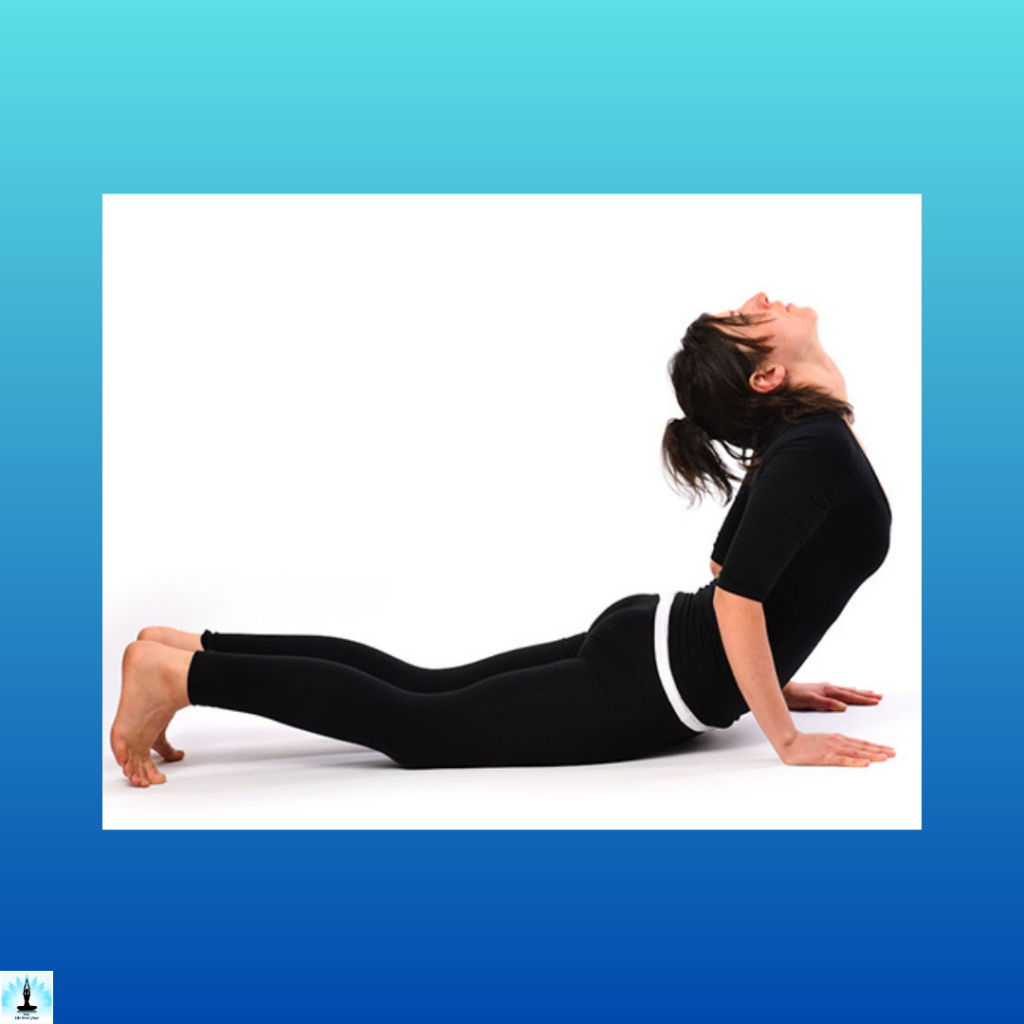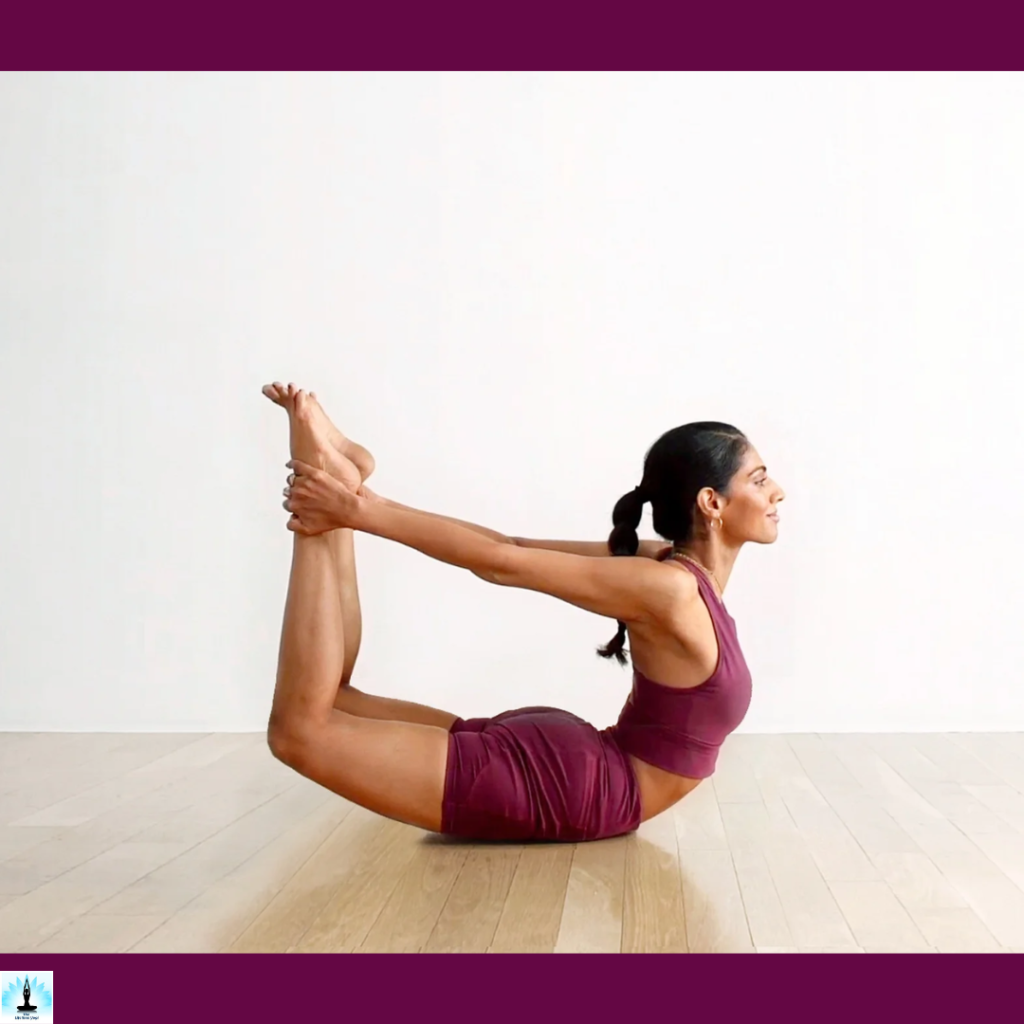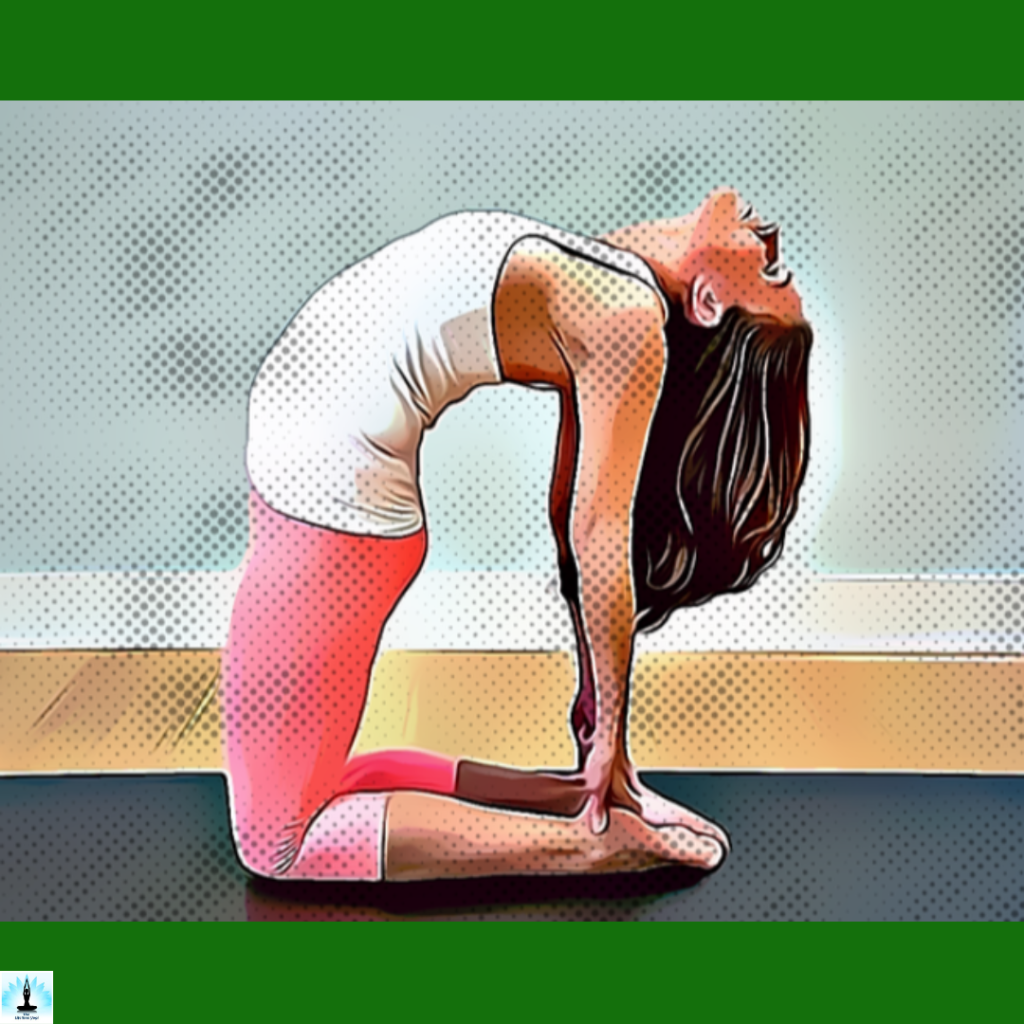Introduction – 7 Top Benefits of Shalabhasana | Step-by-Step Instructions of Locust Pose
In the vast notions of yoga, where poses are like symbols in a language of movement and meditation, Shalabhasana emerges as a powerful and transformative posture. Commonly known as Locust Pose, this asana offers a unique blend of strength, flexibility, and rejuvenation.

As practitioners lift their legs and chest off the ground, it symbolizes the soaring spirit, akin to a locust taking flight. In this blog, we will delve into the intricacies of Shalabhasana, exploring its physical benefits, the philosophy behind its name, step-by-step instructions, variations, and the holistic impact it can have on the body and mind.
Table of Contents
The Yogic Philosophy of The Shalabhasana
The name “Shalabhasana” is derived from the Sanskrit words “Shalabha,” which translates to “grasshopper” or “locust,” and “asana,” meaning “pose” or “posture.” The choice of this name holds profound symbolism in yogic philosophy.
The locust, a creature known for its ability to jump great distances, signifies the power of taking flight and transcending limitations. In a similar vein, practitioners of Shalabhasana are encouraged to rise above physical and mental constraints, reaching towards new heights in their practice and self-discovery.
This connection between the pose and the symbolism of the locust adds a layer of depth to the physical practice, aligning it with the broader philosophy of yoga.
Top Benefits of Shalabhasana

1. Strengthens the Lower Back:
Shalabhasana is a potent backbend that targets the muscles along the spine, particularly strengthening the lower back. The act of lifting the legs and chest off the ground engages the lumbar region, promoting stability and resilience in the lower back muscles.
2. Tones Buttocks and Thighs:
The pose actively involves the muscles in the buttocks and thighs. As practitioners lift their legs, these muscle groups are toned and strengthened. This not only contributes to improved lower body strength but also enhances the overall muscular balance.
3. Improves Posture:
Regular practice of Shalabhasana helps in correcting and enhancing posture. The engagement of the back muscles encourages the spine to align correctly, reducing the tendency for slouching. Improved posture, in turn, contributes to a more confident and poised physical presence.
4. Stimulates Abdominal Organs:
The pose stimulates the abdominal organs, including the organs of the digestive system. This stimulation aids in better digestion, helps alleviate issues related to indigestion, and contributes to a healthier metabolism.
5. Opens the Chest and Improves Lung Capacity:
Shalabhasana involves lifting the chest off the ground, actively opening and expanding the chest cavity. This action enhances lung capacity and respiratory function. Practicing this pose regularly can be beneficial for individuals looking to improve their breathing patterns.
6. Invigorates the Entire Body:
The dynamic nature of Shalabhasana brings an overall sense of invigoration to the body. As the practitioner lifts the legs and chest, there is an energizing effect that reaches throughout the body, promoting vitality and awakening dormant energy.
7. Encourages Confidence and Courage:
The symbolism associated with the locust, which can jump great distances, adds a layer of mental and emotional benefits to Shalabhasana. The act of lifting and expanding the chest encourages an open-hearted and confident posture. Practitioners often experience a sense of empowerment and the courage to face challenges on and off the mat.
Step-by-Step Instructions of Locust Pose
Locust Pose, or Shalabhasana, is a backbend that targets the muscles along the spine and strengthens the lower back. Here’s a step-by-step guide on how to practice this pose:
1. Start in a prone position:
- Lie on your stomach with your legs straight and feet hip-width apart.
- Place your arms alongside your body, palms facing up.
2. Forehead on the mat:
Rest your forehead on the mat, keeping your neck in a neutral position.
3. Engage your legs:
- Firmly press the tops of your feet into the mat.
- Activate your leg muscles by engaging your quadriceps.
4. Inhale and lift your legs:
- On an inhalation, lift your legs off the mat. Keep them straight and strong.
- Lift your legs using the strength of your lower back, not just by squeezing your buttocks.
5. Lift your chest:
As you continue to inhale, lift your chest off the mat. Keep your gaze downward to maintain a neutral neck position.
6. Extend your arms:
- Reach your arms back alongside your body, palms facing down.
- Ensure your shoulders are relaxed away from your ears.
7. Hold the pose:
- Hold the pose for a few breaths, maintaining the lift in your legs and chest.
- Focus on lengthening your spine and reaching energy through your fingertips and toes.
8. Exhale and release:
- Slowly lower your legs and chest back to the mat on an exhale.
- Rest with your forehead on the mat and arms by your sides.
Tips:
- Keep your movements controlled and avoid any jerky motions.
- Engage your core muscles to support your lower back.
- If you have neck issues, keep your gaze forward instead of lifting your head.
Advance Variations of Shalabhasana
Once you’ve mastered the basic form of Shalabhasana, there are advanced variations that can deepen the pose and further challenge your strength and flexibility. Here are a few advanced variations to explore:
1. Extended Locust Pose (Utthita Shalabhasana):

- From the traditional Locust Pose, extend your arms forward and lift them off the mat.
- Simultaneously lift your legs higher, creating a longer line in your body.
- Engage your core to maintain stability and balance in this extended position.
2. Interlaced Fingers Variation:

- Start in the standard Locust Pose position.
- Interlace your fingers behind your back.
- Lift your chest and legs while keeping your hands interlaced.
- This variation enhances the opening in the chest and shoulders.
3. Bent Knee Variation:
- Begin in the standard Locust Pose.
- Bend your knees, bringing your heels toward your buttocks.
- Reach back and hold onto your ankles.
- Lift your chest and thighs, creating a deeper backbend.
Therapeutic Applications of Shalabhasana
Shalabhasana, commonly known as Locust Pose, is a yoga asana celebrated for its therapeutic benefits, particularly in addressing specific physical and mental concerns. This pose plays a pivotal role in strengthening the lower back muscles, such as the erector spinae, making it beneficial for individuals experiencing mild lower back pain.
Besides, the engagement of muscles along the sciatic nerve during the pose can help alleviate symptoms associated with sciatica, providing relief through enhanced flexibility and circulation in the lumbar and sacral regions.
Poses Related to Shalabhasana
Shalabhasana, or Locust Pose, is a dynamic yoga posture that engages various muscle groups, and its benefits can be complemented by practicing poses that focus on similar areas of the body or offer additional stretches. Here are some poses that can be considered complementary to Shalabhasana:
Preparatory Poses of Shalabhasana
Bhujangasana (Cobra Pose):

Both Shalabhasana and Bhujangasana involve backbends, but Cobra Pose is performed with the arms bent, placing more emphasis on the spine’s upper region. This can be an excellent preparatory pose or a follow-up to Shalabhasana, enhancing flexibility in the entire spine.
Dhanurasana (Bow Pose):

Dhanurasana, or Bow Pose, shares the backbend element with Shalabhasana but involves a deeper arch of the spine. It also incorporates a stretch in the front of the body, particularly targeting the shoulders and quadriceps.
Follow-up Poses of Shalabhasana
Ustrasana (Camel Pose):

Camel Pose is another backbend that opens up the chest and strengthens the back muscles. Practicing Ustrasana can provide a counterpose to the abdominal engagement in Shalabhasana, promoting balance in the overall practice.
Setu Bandhasana (Bridge Pose):

While Shalabhasana primarily focuses on the lower back, Bridge Pose targets the spine and engages the glutes and thighs. It serves as an excellent pose to balance the muscular engagement in the back and promote spinal flexibility.
Makarasana (Crocodile Pose):

After the dynamic engagement of Shalabhasana, practicing Makarasana can offer a restorative element. This pose involves lying on the abdomen with the arms crossed, providing a gentle stretch and relaxation for the lower back.
Beginner’s Tip of Shalabhasana
For beginners approaching Shalabhasana, or Locust Pose, it’s crucial to prioritize proper alignment and gradual progression to avoid strain and ensure a safe practice.
Start by lying flat on your stomach with your arms alongside your body and palms facing up. Engage your core muscles gently to protect your lower back. Begin lifting your head, chest, and legs off the mat simultaneously, maintaining a natural extension in the spine.
Focus on keeping your gaze downward to protect your neck and avoid overarched positioning.
Contraindications and Cautions of Shalabhasana
While Shalabhasana, or Locust Pose, offers various benefits, it is essential to be mindful of certain contraindications and precautions to prevent injury and discomfort.
Individuals with lower back issues, such as herniated discs or chronic pain, should approach this pose with caution. Pregnant women, particularly in the later stages of pregnancy, are advised to avoid deep backbends like Shalabhasana.
Those with neck injuries or discomfort should be careful when lifting the head and engaging the neck muscles.
FAQ’s on Shalabhasana
1. Can Shalabhasana Help Alleviate Back Pain?
Yes, Shalabhasana can be beneficial for strengthening the muscles in the lower back, potentially reducing back pain. However, individuals with existing back issues should approach this pose cautiously and may consider modifications.
2. Is Shalabhasana Suitable for Beginners?
Shalabhasana can be challenging for beginners due to its intense backbend. It’s advisable for beginners to start with modifications and gradually progress under the guidance of a qualified yoga instructor.
3. Can Pregnant Women Practice Shalabhasana?
Pregnant women, especially those in advanced stages of pregnancy, are generally advised to avoid deep backbends like Shalabhasana. It’s crucial to prioritize safety and consult with a healthcare professional.
4. How Can I Avoid Straining My Lower Back in Shalabhasana?
Focus on engaging your core muscles and lifting from the back rather than relying solely on leg strength. Gradually increase the height of the lift and avoid overextending, especially if you have a history of lower back issues.
5. Are There Any Variations for Individuals with Neck Discomfort?
If you experience neck discomfort, consider keeping your gaze down and avoiding excessive lifting of the head. Modifying the pose to lift one leg at a time can also reduce strain on the neck.
6. Is Shalabhasana Suitable for Everyone?
Shalabhasana may not be suitable for individuals with certain health conditions like herniated discs, recent abdominal surgeries, or severe back injuries. It’s crucial to consult with a healthcare professional or experienced yoga instructor before attempting this pose.
7. Can Shalabhasana Improve Posture?
Yes, practicing Shalabhasana regularly can contribute to better posture by strengthening the muscles along the spine and promoting awareness of spinal alignment. However, it should be part of a comprehensive yoga practice focusing on overall body awareness.
8. How Can One Intensify the Practice of Shalabhasana?
To intensify Shalabhasana, individuals can gradually work towards lifting both legs simultaneously, ensuring proper engagement of the lower back muscles. Experimenting with variations like lifting the chest higher can also add challenge to the pose.
9. Can Shalabhasana Be Included in A Daily Yoga Routine?
While Shalabhasana offers several benefits, it’s advisable to include it as part of a well-rounded yoga routine that addresses various aspects of flexibility, strength, and balance. A consistent and mindful practice is key to experiencing the full benefits of the pose.
Conclusion
Shalabhasana represents the holistic nature of yoga. Beyond the physical form, it encourages practitioners to explore the depths of their capabilities, both in body and spirit. As one takes flight in Locust Pose, there is a profound invitation to rise above challenges, embrace strength, and soar towards new heights in the transformative journey of yoga. Whether a beginner or an experienced yogi, the exploration of Shalabhasana offers an opportunity to connect with the essence of flight, both on the mat and in the boundless realms of personal growth.
References
- Mehta 1990, p. 92.
- Ghamande, Narayana (1905). Yogasopana Purvacatuska (in Marathi). Janardan Mahadev Gurjar, Niranayasagar Press. p. 65.
- Diamond, Debra; Aitken, Molly Emma (2013). Yoga: The Art of Transformation. Smithsonian Institution. p. 286. ISBN 978-1-58834-459-5.
- Sjoman, Norman E. (1999) [1996]. The Yoga Tradition of the Mysore Palace (2nd ed.). Abhinav Publications. p. 88. ISBN 81-7017-389-2.
- Stiles, Mukunda (2000). Structural Yoga Therapy: Adapting to the Individual. Red Wheel. ISBN 1-57863-177-7.
- Pratap, Vijayendra (1997). Beginning Yoga. Tuttle Publishing. p. 26. ISBN 978-0-8048-2104-9.
